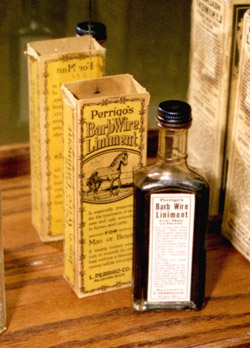
Exhibits & Educational Programs
The Spilger Barbed Wire Collection: Now on permanent exhibit, this collection of 2140 unique samples of barbed wire is one of the largest of its kind in existence. Although only slightly over 500 wires were actually patented, this collection includes numerous similar, but unique variations of patented wires along with many home-made designs. Nearly all known types of barbed wire from the most common to the most unusual are displayed.
The Evolution of Barbed Wire: This exhibit traces the development of barbed wire through illustrations and examples of the many unsuccessful attempts prior to 1873. Included in the exhibit is an original piece of Henry Rose's “Wooden Rail,” the fencing material exhibited at the DeKalb County Fair in 1873 that inspired Joseph Glidden to develop and patent his own barbed wire appropriately named “The Winner.” Visitors may watch barbed wire being made on a re-creation of Glidden's homemade wire making equipment. Learn how a coffee mill, a grind stone and some “farmer ingenuity” came together to create the first strands of barbed wire and launch an industry that reshaped the American frontier.
The Fence Mender: A life-size diorama depicts a cowboy repairing his broken fence line by light of the moon. Under the starry skies, viewers can almost hear the cattle lowing on the hillside behind the thin strands of wire that protect a freshly planted crop. Visitors will learn that farming and ranching work does not stop when the sun goes down.
 Barbed
Wire Liniments: The collection of barbed wire liniment bottles
is an outstanding example of late 19th and early 20th century "medicinal wonders." These medicines promised
to "cure cuts and injuries caused by barbed wire...for man or beast." As you browse the collection,
you will find some recognizable brand names and a few unheard of brands that make promises that conjure up
images of traveling showmen crying, "It'll cure what ails ya' and only for a mere five cents a bottle..."
Barbed
Wire Liniments: The collection of barbed wire liniment bottles
is an outstanding example of late 19th and early 20th century "medicinal wonders." These medicines promised
to "cure cuts and injuries caused by barbed wire...for man or beast." As you browse the collection,
you will find some recognizable brand names and a few unheard of brands that make promises that conjure up
images of traveling showmen crying, "It'll cure what ails ya' and only for a mere five cents a bottle..."
Punch Press Wires: This recently completed display features an unusual fencing-related item, Punch Press Scrap. The material that is left over from a punch press is either melted down or recycled for other uses. The scrap metal strips have been used as decorative fencing or for fence stays. Many times, the strips exhibit an unusual and attractive repetitive pattern.
![]()
Group Tours
Groups are always welcome. We can comfortably accomodate groups of most any size.
We provide a variety of guided tour options and can tailor your tour to the to the age level and interests
of your group. We are also happy to coordinate your visit with the local historical museums, or other area
attractions. There is no admission fee, but the museum requests an honorarium for guided tours. Call the
museum office at 785-222-9900 or e-mail barbedwire@rushcounty.org
to the attention of Museum Tours Coordinator.
Guest Speakers
Veteran barbed wire collectors and museum staff
are always willing to present programs for your school or organization.
We offer a variety of programs including Power Point presentations and
hands-on displays. Costs are minimal and include mileage and a small honorarium for the presenter.
For those interested in starting their own barbed wire collections, we can sponsor workshops and
hands-on demonstrations. Contact the Museum Education Coordinator for details.
Educational Programming
The Kansas Barbed Wire Museum is in process of
developing a variety of educational kits and materials available for loan to educators.
Contact the Museum Education Coordinator for more information.
![]()
Traveling Exhibits Available for Lease
The Donald Taylor Barbed Wire Collection
This new traveling exhibit, produced by the Kansas
Barbed Wire Museum, tells the story of barbed wire through text and hundreds
of unique samples of authentic barbed wire. A variety of educational materials
also accompanies this exhibition. Museums and Historical Societies interested
in leasing the exhibit may contact the Museum Education Coordinator for more
information.
 The display consists of 4 hinged display boards, 3 feet in height by 4 feet in width. The display can be
set up on 2 - standard 8-foot tables, or can easily fit on a single 8-foot table if space is limited. It is composed
of a cross section of actual barbed wire specimens and explains their development and uses. A variety of
supplemental educational materials and demonstration specimens are also available.
The display consists of 4 hinged display boards, 3 feet in height by 4 feet in width. The display can be
set up on 2 - standard 8-foot tables, or can easily fit on a single 8-foot table if space is limited. It is composed
of a cross section of actual barbed wire specimens and explains their development and uses. A variety of
supplemental educational materials and demonstration specimens are also available.